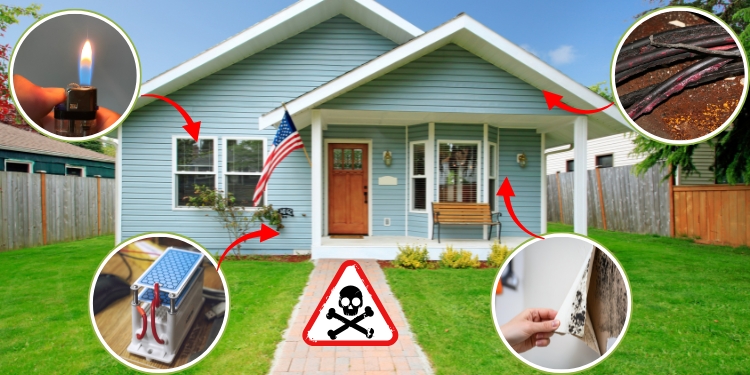How Much Ammo Do You Need for SHTF?

When people talk about preparedness, ammo tends to get tossed around like it’s candy at a parade. Some folks stockpile thousands of rounds for every caliber under the sun. Others think two boxes of 9mm ammunition in the nightstand drawer should suffice. So… how much is actually enough?
Let’s cut through the social media firestorm that can arise when discussing this issue and get to the real numbers—for pistols, rifles, and shotguns—with a focus on personal and family defense.
I want to caveat this by stating that this is about having enough ammunition on hand to ensure you’re fairly well-prepared for what may come. This isn’t about firefights with roving marauders or starting your own militia. It’s about protecting your home, your loved ones, and your immediate perimeter — if and when the normal systems fail.
TL;DR: Base your ammo supply on function, not fantasy. Cover training, defensive use, and a few reloads per weapon. Once you’re squared away, move on.
Quick Look at What You’ll Learn
Disclaimer: How much ammo you should have socked away is a personal issue based on your situation, tolerances, budget, etc. Therefore, as always, take what is suggested here and modify it to your own needs.
Why This Matters
In a real-world collapse, things don’t always fall apart all at once. They chip away. Power goes. Phones go. Effective law enforcement fades into the background. And then, people get desperate. That’s when the ability to defend your home stops being a theory. If you don’t have what it takes, ammo included, you could be in for a rough time.
Most people underestimate how fast you can burn through ammo in a true breakdown. This isn’t about having massive firefights. And, it’s being prepared in case bad people come to take what you have. The fact is, like it or not, in today’s world, the best form of defense available to people here in the U.S. is a firearm. In the PACE plan of ways to defend yourself, firearms are the primary form of defense for most people.
That’s where how much ammo you should store for an STHF event comes in. Well, with no guarantee of resupply. Once it starts, what you’ve got is what you’ve got. So, I’d err on the side of caution when it comes to keeping your primary source of defence fully operational.
Key Assumptions
This isn’t based on fantasy firefights or Hollywood. Here’s the framework this article uses:
- You’re defending a household (1–5 people) in a sustained disruption
- You have a pistol, a rifle, and possibly a shotgun
- You’re not actively patrolling. You’re protecting your home
- You might have to train, re-zero, and hand off ammo to others
- You want to hit a “good enough” amount of ammo, not chase the infinite
Recommended Ammo Counts (Minimum vs. Ideal)
These are per weapon. Multiply based on how many people in your household will be armed with the weapon. When it comes to your firearms, I like to think of them as a system. A rifle and everything involved with it—magazines, ammo, cleaning kit, case, etc., are all part of that system. The same goes for pistols and every firearm you have.
Handgun (Pistol)
Handgun Ammo Recommendations
| Level | Training Ammo | Defensive Ammo | Magazine Count |
|---|---|---|---|
| Minimum | 100 | 150 | 3 |
| Ideal | 1000 | 300 | 10 |
- Pistols are the EDC of your firearms setup. They’re meant to keep you in the fight until you’ve ended the fight, or until you can get your rifle into operation. They’re with you 24/7.
- Magazines: Minimum of three—one in pistol, two spare. You have enough at an even dozen.
- Round Types: FMJ for training and jacketed hollow-point (JHP) for defensive ammunition. If you’re running a suppressor, be sure to consider subsonic rounds.
- Pro-Tip: Plan out your range time so that you know how many magazines you’ll need to complete your training without having to reload. Use that number and add your three base, self-defense magazines, and you should be good to go.
Rifle (Semi-Auto)
Rifle Ammo Recommendations
| Level | Training Ammo | Defensive Ammo | Magazine Count |
|---|---|---|---|
| Minimum | 300 | 500 | 7 |
| Ideal | 1000 | 2000 | 15 |
- Rifles are the cornerstone of defensive firepower for most people.
- These numbers cover both deterrence and sustained capability.
- You want enough to reload all your mags several times over.
- Rifle Magazines: I’d start with a minimum of seven and aim for at least a 1.
- Round Types: FMJ for training and defensive ammo. Jacketed soft point also makes a worthwhile defensive round.
Shotgun (12ga)
Shotgun Ammo Recommendations
| Level | Training Ammo | Defensive Ammo |
|---|---|---|
| Minimum | 150 | 50 |
| Ideal | 450 | 150 |
- Great for close quarters and home defense.
- Round Types: Birdshot for training and hunting. Buckshot for primary defensive ammo. Slugs for punching through vehicles.
Storage for Longevity
Ammunition can be ruined by poor storage. If you store your ammo properly, it’ll last for decades. Store it incorrectly, and your investment can transform from a stockpile of ammo to a pile of corrosion. Here’s how to keep it battle-ready for the long haul:
- Store in cool, dry places — no garages or sheds with temp swings
- Use sealed ammo cans with silica gel packs to keep moisture out
- Keep off concrete floors — store on pallets or shelves. Concrete can absorb and release moisture over time, especially during fluctuations in humidity, which can lead to condensation under metal ammunition cans and accelerate corrosion. While plastic/composite cans don’t corrode like metal, they still benefit from being elevated to avoid moisture buildup underneath and to reduce temperature fluctuations.
- Label and rotate — the oldest ammo gets used for training.
The Bottom Line
Ammo is one of those things people either wildly underestimate—or obsess over. The truth sits somewhere in between. You don’t need pallets stacked to the ceiling, and you definitely don’t want to realize too late that three boxes weren’t enough.
The numbers in this guide aren’t fantasies or clickbait—they’re grounded, scalable starting points. Enough to cover realistic defensive use, training, and handoff to another household member if needed.
Once you’ve got a defensible supply for each firearm—and the magazines to support it—you’re no longer behind the curve. That’s the moment you stop second-guessing yourself and start focusing on everything else that keeps you alive and independent.
Because when things go sideways, the worst feeling in the world is realizing what you should’ve done months ago.
Additional Resources
Frequently Asked Questions
How long can ammo last in storage?
If kept in a cool, dry place in sealed containers with desiccants, modern ammunition can easily last 20–30 years or longer without issue.
Should I mix different brands of ammo?
For training, it’s fine. For defense, it’s better to stick with one brand and load to avoid variations in reliability and accuracy.
Is steel-cased ammo okay to store and use?
Yes—for training. It’s cheaper, but can be harder on extractors and doesn’t store quite as well as brass-cased ammo.
Do I need to rotate my defensive ammo?
It’s smart to rotate defensive ammo every 1–2 years and use the old stuff for training.
How can I determine if old ammunition is still viable?
Check for corrosion or discoloration. If it looks clean and was stored well, it’s likely still good. When in doubt, test-fire a few rounds.
Read the full article here









